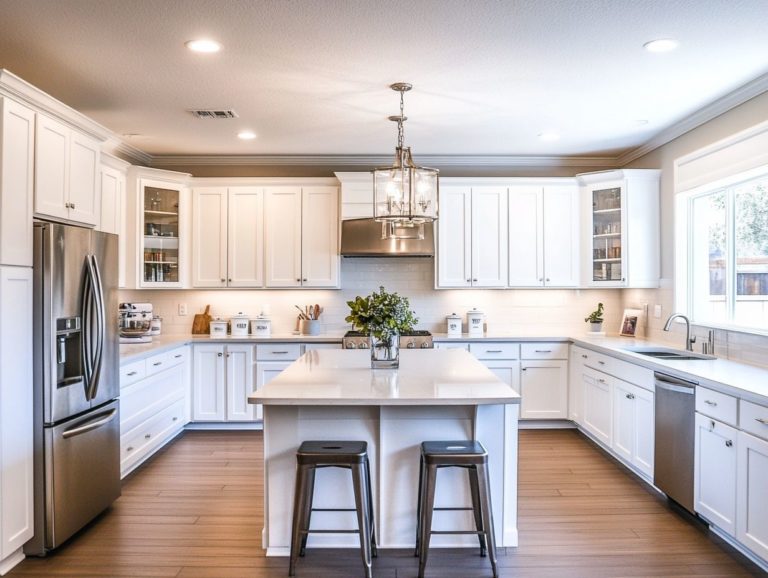5 Layout Strategies for a Multi-Functional Kitchen
In today’s fast-paced world, your kitchen needs to be more than just a place to serve meals; it should be a hub of efficiency, style, and functionality.
Whether you’re an enthusiastic chef, a family entertainer, or simply aiming to maximize your space, crafting a multi-functional kitchen layout is essential.
This article delves into five innovative layout strategies designed to help you utilize space effectively, create distinct zones for various activities, and incorporate smart storage solutions.
You’ll uncover the latest trends, learn about common pitfalls to steer clear of, and receive tips for seamlessly blending design styles.
Prepare to transform your kitchen into a versatile and inviting space!
Contents
- Key Takeaways:
- 1. Utilize Every Inch of Space
- 2. Create Zones for Different Functions
- 3. Consider a Kitchen Island
- 4. Incorporate Smart Storage Solutions
- 5. Keep the Layout Open and Inviting
- How Can a Multi-Functional Kitchen Improve Efficiency?
- What Are the Most Important Factors to Consider in a Multi-Functional Kitchen Layout?
- How Can One Create a Functional and Aesthetically Pleasing Kitchen Layout?
- What Are the Common Mistakes to Avoid in a Multi-Functional Kitchen Layout?
- How Can One Incorporate Different Design Styles in a Multi-Functional Kitchen?
- What Are the Latest Trends in Multi-Functional Kitchen Layouts?
- Frequently Asked Questions
- What are the 5 layout strategies for a multi-functional kitchen?
- How does the L-shaped layout work for a multi-functional kitchen?
- What are the advantages of a U-shaped layout for a multi-functional kitchen?
- How can a galley layout benefit a multi-functional kitchen?
- What are the benefits of incorporating an island in a multi-functional kitchen layout?
- What can an open concept layout offer for a multi-functional kitchen?
Key Takeaways:
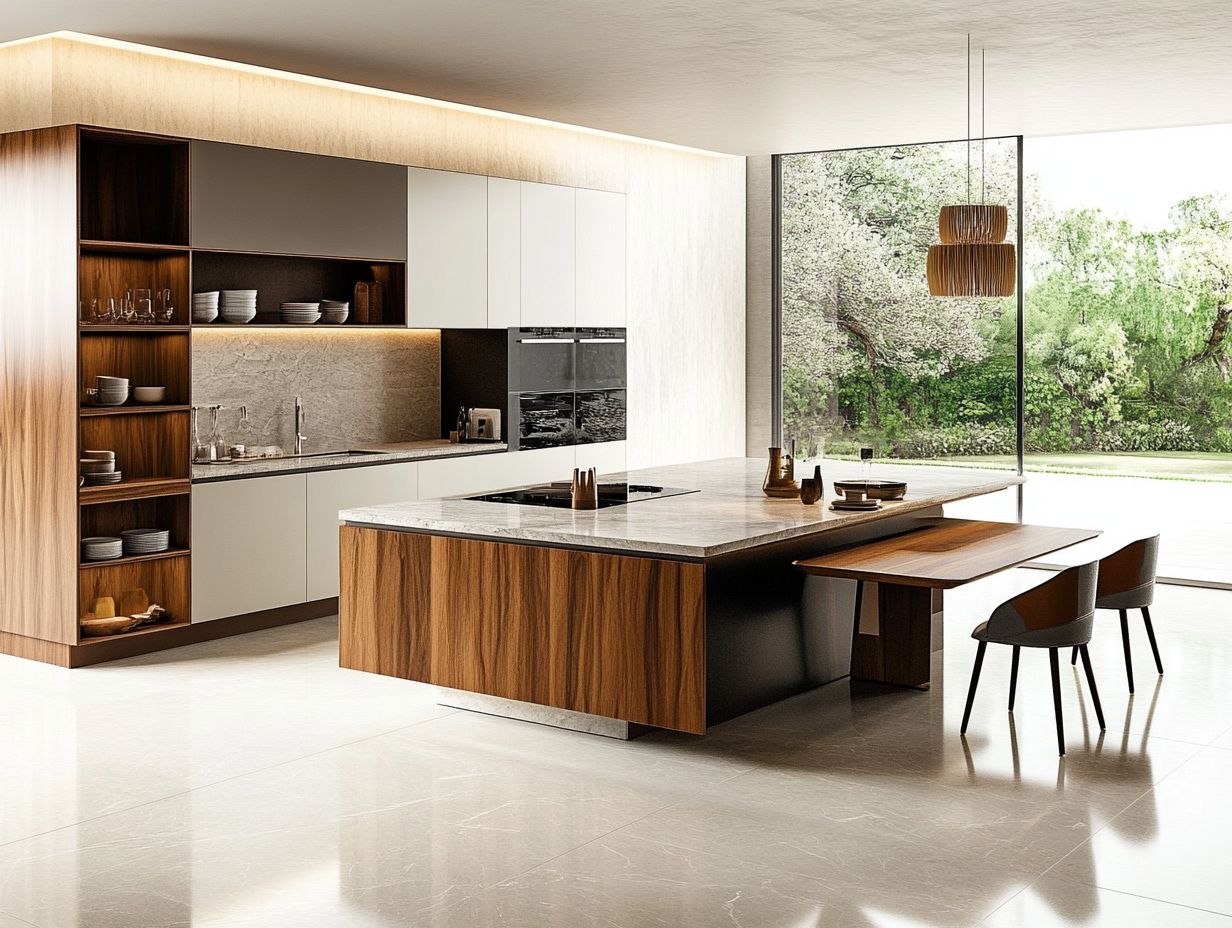
- Utilize every inch of space in a multi-functional kitchen to maximize efficiency and functionality.
- Create designated zones for different functions, such as cooking, dining, and storage, to keep the kitchen organized and easy to navigate.
- Consider incorporating a kitchen island for added counter space and storage, as well as a central focal point in the room.
1. Utilize Every Inch of Space
In kitchen design, making the most of every inch is essential for creating a space that is both functional and visually stunning.
With thoughtful planning and attention to layout, you can maximize space efficiency. Each appliance, storage solution, and surface should serve a distinct purpose without compromising on style.
To elevate your kitchen, consider incorporating vertical storage options like wall-mounted shelves or cabinets. This will significantly increase usable space while keeping your countertops clutter-free.
Choosing the right layout—whether L-shaped, U-shaped, or a narrow galley kitchen—is crucial for facilitating smooth traffic flow. This allows you to navigate your kitchen with ease.
Don’t underestimate the benefits of multifunctional furniture. An island that doubles as a dining area or a drop-leaf table for extra prep space can greatly enhance efficiency.
The kitchen triangle, which means having the stove, sink, and refrigerator close together for easier cooking, will streamline your meal prep and cooking processes.
2. Create Zones for Different Functions
Creating distinct zones within your kitchen elevates functionality by clearly defining areas for cooking, cleaning, and dining.
To truly harness these benefits, position your cooking zone close to essential appliances like the stove and refrigerator. This strategic placement facilitates a seamless meal preparation experience.
The cleaning zone should be conveniently located near the sink and dishwasher, simplifying the post-cooking cleanup process. Consider a dining area that promotes interaction, ideally positioned near both the cooking and cleaning zones.
This fosters a communal atmosphere where family and friends can gather and connect. Such a thoughtful layout not only streamlines your tasks but also creates a welcoming environment.
Get ready to revamp your kitchen!
3. Consider a Kitchen Island
Incorporating a kitchen island can elevate both the functionality and aesthetics of your kitchen, transforming it into a versatile space for cooking, dining, and socializing.
It can truly become the heart of your home, where family and friends gather to create lasting memories over a shared meal or casual conversation.
With a variety of design options at your disposal, you can customize the island to include built-in appliances like stovetops or wine coolers. This will streamline your meal prep process.
Additional storage solutions such as drawers and shelves will help keep clutter at bay while enhancing the island’s overall style.
By thoughtfully selecting materials and colors, you can ensure that the island beautifully complements your kitchen’s decor and layout, making it feel like a seamless part of your design rather than just an afterthought.
Start your transformation now and discover the joy of a well-designed kitchen!
4. Incorporate Smart Storage Solutions
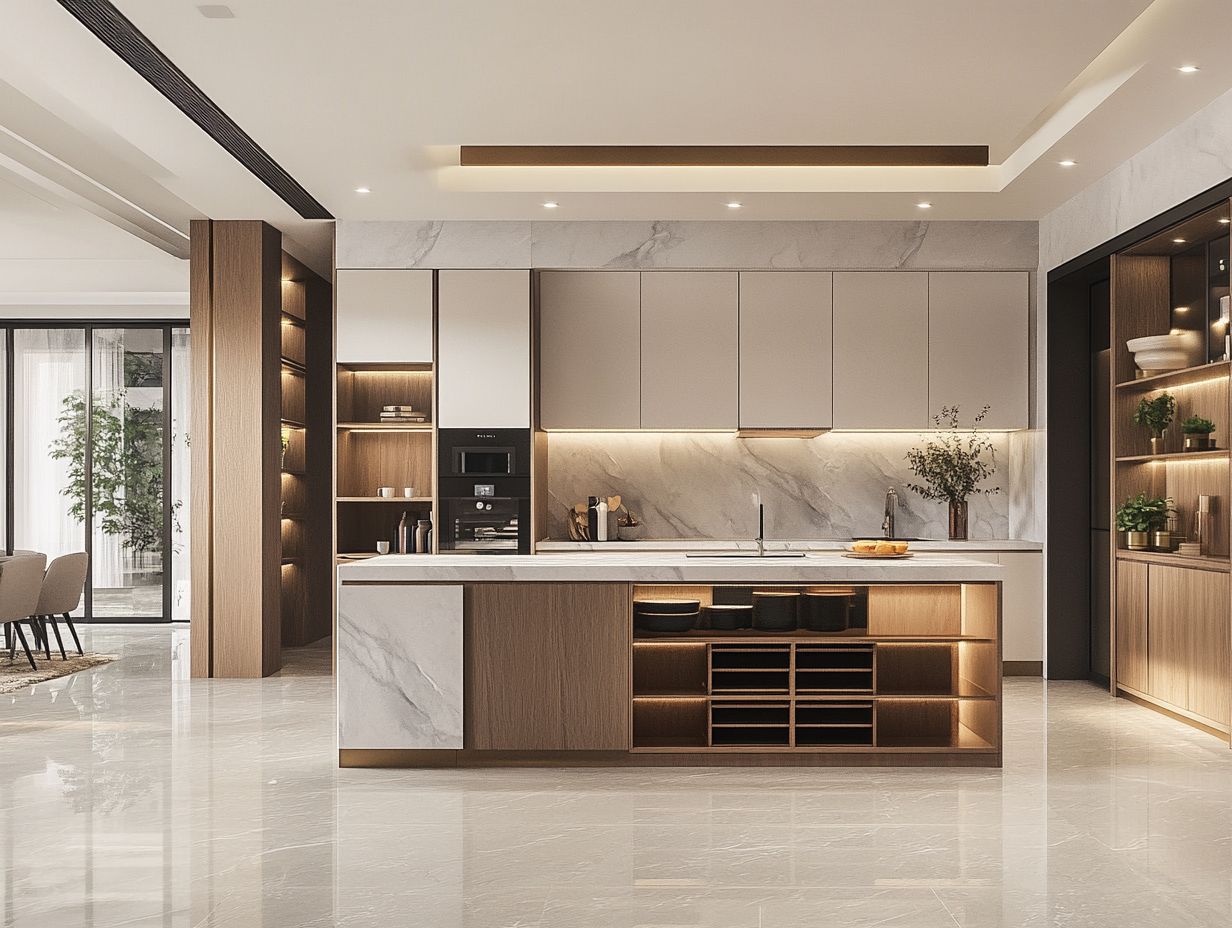
Incorporating smart storage solutions in your kitchen is key to maintaining organization and efficiency. Enjoy quick access to your tools while keeping your surfaces clutter-free!
Among the many options available, pull-out shelves stand out as particularly advantageous. They effortlessly bring hard-to-reach items right to your fingertips, eliminating the frustration of digging through deeper cupboards.
Lazy Susans are another excellent choice, especially for corner cabinets. They ensure that your spices and condiments are readily accessible without the need for tedious rummaging.
Vertical cabinets maximize your space by storing cutting boards, baking sheets, and other flat items upright. This makes them easy to see and grab when you need them.
By integrating these storage solutions, you can streamline your cleaning tasks and enhance the overall functionality of your kitchen, transforming it into a more enjoyable and efficient cooking environment.
5. Keep the Layout Open and Inviting
An open and inviting kitchen layout encourages interaction and cultivates a warm atmosphere, essential for family gatherings and entertaining guests. This design encourages communication and promotes easy movement, minimizing congestion during bustling cooking sessions.
The thoughtful arrangement of furniture and decor can significantly enhance this inviting ambiance. By strategically placing bar stools around an island or incorporating a cozy breakfast nook, you can enjoy casual conversations while whipping up delicious meals.
Choosing functional decor items that also serve as storage solutions helps maintain a spacious yet organized environment. This ensures your kitchen remains the heart of the home without sacrificing practicality.
How Can a Multi-Functional Kitchen Improve Efficiency?
A multi-functional kitchen elevates your culinary efficiency by seamlessly integrating various cooking, cleaning, and dining tasks into a cohesive design that enhances usability and organization.
This thoughtfully crafted space fosters an atmosphere where your culinary creations can flow effortlessly, all while serving as a welcoming hub for family and friends.
Picture yourself whipping up a gourmet meal and effortlessly engaging with guests seated nearby, thanks to strategically placed islands and stools that encourage interaction.
Essential appliances, like a smart oven or a dual-fuel cooktop, are perfectly suited to this layout, making meal preparation enjoyable and efficient.
Innovative storage solutions, such as pull-out pantries and overhead racks, ensure your essential tools and ingredients are always within easy reach. This comprehensive approach minimizes clutter and streamlines your household tasks, allowing for a more harmonious living experience.
What Are the Most Important Factors to Consider in a Multi-Functional Kitchen Layout?
When designing a multi-functional kitchen layout, it’s crucial to consider essential factors like functionality, comfort, and traffic flow to create the perfect cooking and dining environment.
The kitchen triangle, formed by the stove, sink, and refrigerator, is a foundational element that maximizes your efficiency during meal preparation. Prioritizing the careful placement of appliances is key; they should be accessible and comfortably within reach to minimize strain and boost productivity.
Ensure you allocate adequate space for various household activities—cooking, eating, and entertaining—so you can multitask seamlessly.
By optimizing traffic flow, you can avoid bottlenecks in high-traffic areas, creating a harmonious space that encourages collaboration and accommodates both everyday life and special gatherings.
How Can One Create a Functional and Aesthetically Pleasing Kitchen Layout?
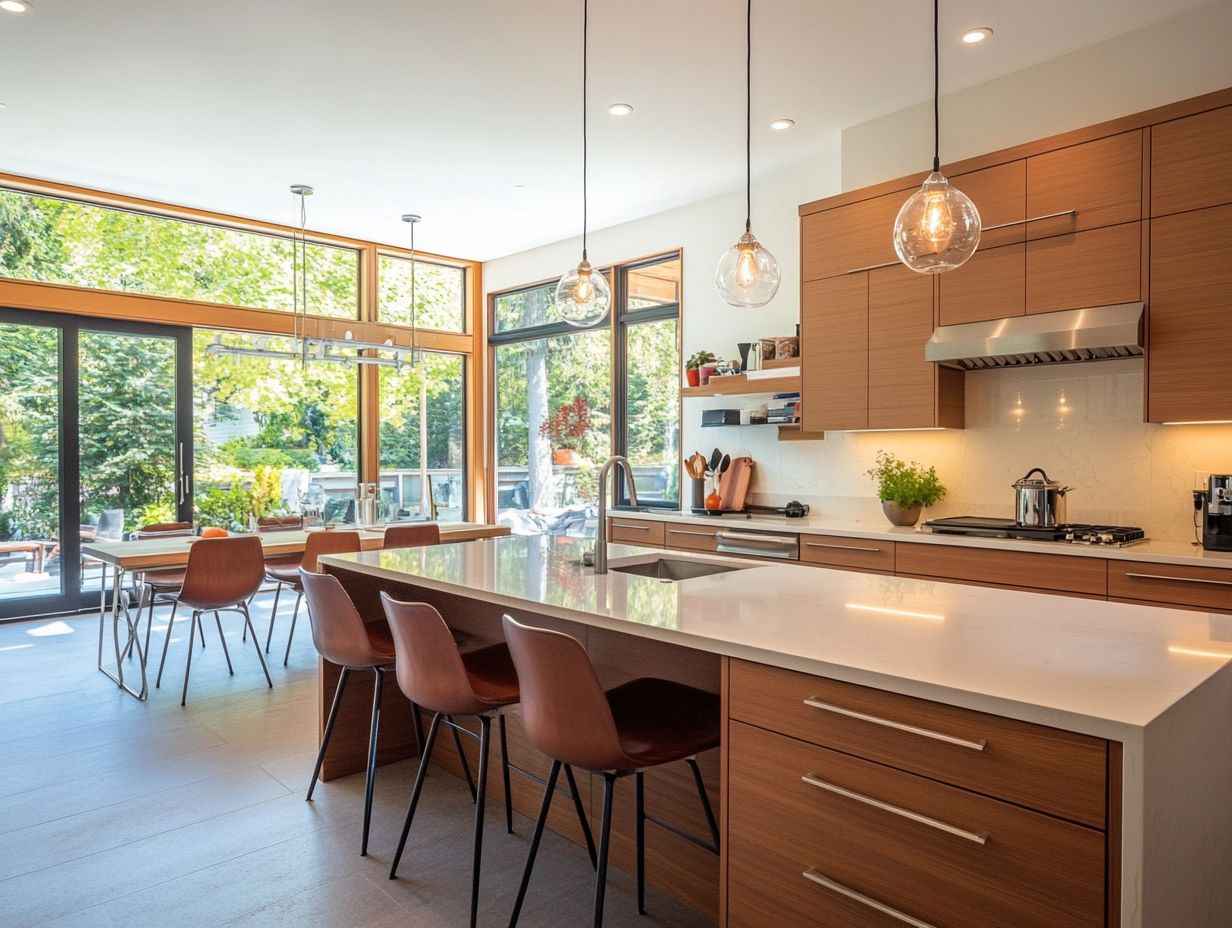
Achieving a functional and aesthetically pleasing kitchen layout requires a delicate balance of design elements, practical features, and thoughtful decor choices.
To strike this balance effectively, focus on selecting the right color schemes that bring warmth while promoting an energetic ambiance. Think soft earth tones or refreshing blues.
The choice of cabinetry plays a crucial role in both utility and style. Opt for sleek, modern designs paired with innovative storage solutions to create an uncluttered and sophisticated space.
Choosing durable materials for surfaces, like quartz or reclaimed wood, enhances visual appeal and ensures longevity.
Incorporating thoughtful decor elements, such as strategically placed plants or stylish light fixtures, elevates the overall atmosphere without sacrificing functionality. This makes your kitchen both inviting and practical.
What Are the Common Mistakes to Avoid in a Multi-Functional Kitchen Layout?
Avoiding common mistakes in a multi-functional kitchen layout is essential for ensuring both functionality and efficiency in your cooking and dining experience.
Plan your kitchen with flow and functionality in mind. Ensure each element is intuitively placed to enhance your culinary journey.
Common pitfalls include:
- Placing large appliances too far apart, which can hinder your movement and create frustration during meal prep.
- Insufficient storage solutions can lead to clutter, making it challenging to find essential items when you need them.
By thoughtfully organizing work zones and maximizing vertical space for storage, you can improve accessibility and create a harmonious environment that fosters creativity and enjoyment in the kitchen.
How Can One Incorporate Different Design Styles in a Multi-Functional Kitchen?
Adding various design styles into your multi-functional kitchen can elevate its aesthetics while ensuring the space remains both practical and enjoyable.
By blending modern, rustic, and industrial elements, you can create an inviting atmosphere that reflects your unique taste. A harmonious color palette is key. Use neutral tones as a base, layering in rich textures and bold accents that capture rustic charm alongside sleek modern finishes.
Using materials like reclaimed wood for cabinetry, stainless steel for appliances, and ceramic tiles for backsplashes seamlessly unites these styles. Selecting decor pieces, such as vintage light fixtures or contemporary art, further enriches your overall design, resulting in a kitchen that is as beautiful as it is functional.
What Are the Latest Trends in Multi-Functional Kitchen Layouts?
The latest trends in multi-functional kitchen layouts invite you to embrace innovation in design, functionality, and the seamless integration of smart appliances, all aimed at elevating your culinary experience.
Modern kitchens now prioritize open kitchen layouts that combine cooking and living spaces for better social interaction, effectively dismantling barriers between cooking, dining, and entertaining areas.
The inclusion of smart home technology, like voice-activated systems and automated lighting, gives you the power to streamline daily tasks while enhancing energy efficiency.
Using sustainable materials—from recycled countertops to eco-friendly cabinetry—not only contributes to a healthier environment but also elevates aesthetic appeal, perfectly aligning with the growing demand for environmentally conscious living.
Together, these elements harmonize to create visually stunning and practical spaces that cater to the diverse needs of your contemporary lifestyle.
Frequently Asked Questions
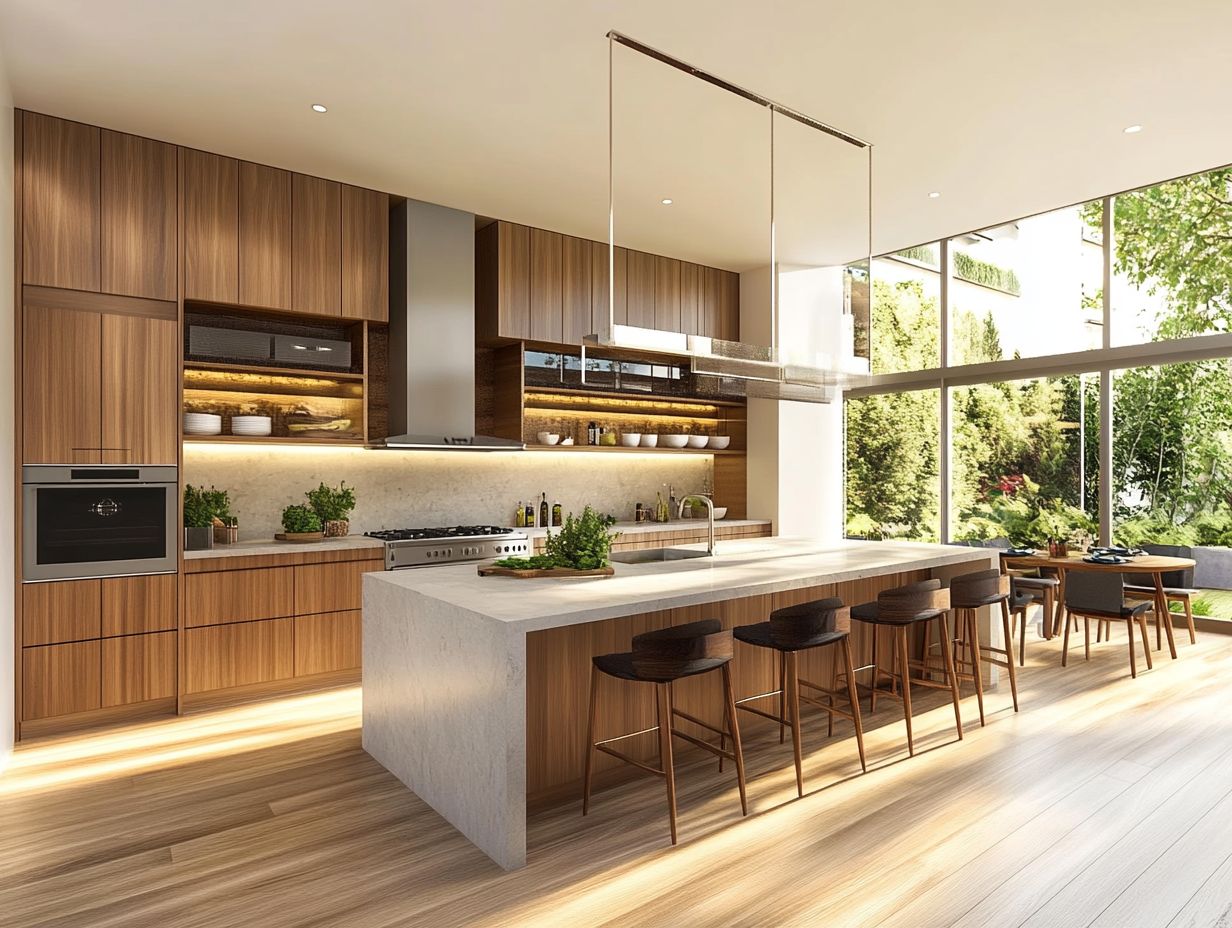
What are the 5 layout strategies for a multi-functional kitchen?
The 5 layout strategies for a multi-functional kitchen include:
- L-shaped layout
- U-shaped layout
- Galley layout
- Island layout
- Open concept layout
Each layout offers unique benefits and caters to different kitchen needs.
Start planning your dream kitchen layout today!
How does the L-shaped layout work for a multi-functional kitchen?
The L-shaped layout is perfect for small to medium-sized kitchens. It maximizes counter and storage space while easily accommodating multiple cooks.
What are the advantages of a U-shaped layout for a multi-functional kitchen?
The U-shaped layout is fantastic for larger kitchens. It offers ample counter and storage space, along with a clear work triangle that enhances movement.
How can a galley layout benefit a multi-functional kitchen?
The galley layout shines in narrow spaces. It efficiently utilizes available space while providing easy access to all kitchen areas.
What are the benefits of incorporating an island in a multi-functional kitchen layout?
Islands act as a stunning focal point in the kitchen. They add extra counter space and can serve as a breakfast bar or additional seating, transforming the kitchen into a social hub.
What can an open concept layout offer for a multi-functional kitchen?
An open concept layout creates a seamless flow between the kitchen and living spaces. This design is perfect for entertaining, as it allows for more natural light and a spacious feel.


